|
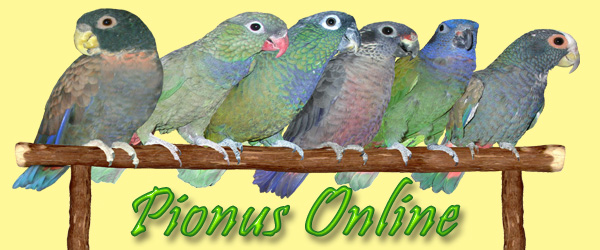

On this page is shown the Technical Descriptions of each
specie of the Pionus Parrot.
A photo is shown beside each specie except for the last two species at
this time until
I can obtain a photo it will remain that way, the first 6 photos are of my
own parrots!
| |
|
Blue-Headed
(Pionus menstruss)
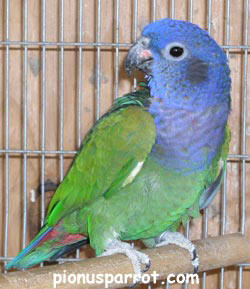 Description:
generally green; head and upper breast deep blue, red base to feathers of neck,
which show through partially; black patch to ear-coverts; under tail-coverts
red; bill blackish, reddish on sides; skin to periophthalmic ring grey; iris
dark brown; feet grey. Description:
generally green; head and upper breast deep blue, red base to feathers of neck,
which show through partially; black patch to ear-coverts; under tail-coverts
red; bill blackish, reddish on sides; skin to periophthalmic ring grey; iris
dark brown; feet grey.
Off Springs: with reddish frontal band, head greenish-blue.
Weight & Length:
230-245 grams. 28 cm (11 ins)
Distribution:
Colombia (east of Andes), eastern Ecuador, eastern Peru south to central Brazil
and northern Bolivia; Trinidad.
Habitat:
forest and terrain with trees of tropical zone to 600 m (2,000 ft), occasionally
up to 1,500 m (5,000 ft); only sighted in open country and cultivated areas when
foraging.
Status:
menstruus and rubrigularis common, but threatened with extinction.
Habits:
in small groups or noisy flocks of up to 100 individuals outside breeding
season; mostly remains in canopy of tall trees or palms.
Natural diet:
fruits, berries, seeds and tree flowers; occasionally raids grain fields and
banana plantations; regularly visits "barreiros" for mineral-rich soil.
Breeding behavior:
breeding season in central America from February to April, in Colombia as early
as November/December and in
Surinam
from September/October; nests in tree holes or hollow branches; clutch 3 to 4
eggs; egg measures 31.5 x 25.1 mm (1.24 x 1.00 ins).
Aviculture:
medium-noisy parrot with usually little chewing requirement; initially shy,
later still reticent; fairly susceptible to stress as most Pionus species; many
birds do not bathe, but enjoy being rained on.
Accommodation:
Ideally aviary of at least 2.5 x 1 x 2 m (8.5 x 3 x 6 ft); in winter between 5°
(41°F) and 10°C (50°F); double wiring necessary as can be aggressive to birds in
neighboring flights.
Diet:
various fruit and vegetables; variable seed mix, in spring/summer sprouted food;
fresh branches with buds; regular mineral supplements; rearing food or dog chow,
soft or cottage cheese before and during breeding period.
Breeding in
aviculture:
regularly achieved; breeding begins in May; 3 to 4 eggs; brooding mostly starts
with second egg; incubation 26 days; fledging period 70 days; young independent
at 90 days; nest box size 25 x 25 x 50 cm (10 x 10 x 20 ins).
|
|
Bronze-Winged
(Pionus chalopterus)
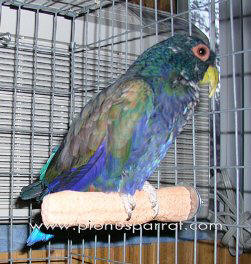 Description: violet-blue; head and nape bronze-brown, feathers broadly
edged dark violet-grey; chin white; throat dull pink; back, rump and shoulder
feathers dark bronze-green with blue edging; breast and abdomen dark green
broadly edged with dark violet-blue; under tail-coverts red; wing-coverts
bronze-brown; primary-coverts and primaries purple-blue; tail dark blue, outer
feathers with red base; bill yellowish horn-color; skin to periophthalmic ring
dull to dark pink; iris brown; feet flesh-colored. Description: violet-blue; head and nape bronze-brown, feathers broadly
edged dark violet-grey; chin white; throat dull pink; back, rump and shoulder
feathers dark bronze-green with blue edging; breast and abdomen dark green
broadly edged with dark violet-blue; under tail-coverts red; wing-coverts
bronze-brown; primary-coverts and primaries purple-blue; tail dark blue, outer
feathers with red base; bill yellowish horn-color; skin to periophthalmic ring
dull to dark pink; iris brown; feet flesh-colored.
Off Springs: with
greenish head and back, breast and abdomen feathers with dark green edging.
Weight&
Length: 225-240 grams. 29 cm (11.5 ins)
Distribution:
Andes
of Colombia (except Nariño) and furthest northwest Venezuela.
Habitat: forest of tropical and sub-tropical zones between 500 m (1,500 ft)
and 2000 m (6,000 ft); occasionally higher or lower; regular visitor to cleared
and partially deforested areas.
Status: common in localities.
Habits: in pairs or small groups outside breeding season; flies swiftly
and often for great distances; noisy during flight; call shrill.
Natural
diet: seeds; probably also fruits, berries and flowers of trees.
Breeding
behavior: breeding season from April; nests in hollows
in dead trees; egg measures 29,3 x 23,7 mm (1.15 x 0.93 ins).
Aviculture: quiet to medium-noisy; not particularly hard chewer;
nonetheless provide fresh branches regularly; shy and reticent; occasionally
susceptible to stress; during acclimatization also susceptible to cold and
fungal infection; occasionally male plucks female; particularly on head.
Accommodation:
aviary min. 2,5 x 1 x 2 m (7.5 x 3 x 6 ft);
minimum temperature in winter 5°C (41°F).
Diet:
various fruit and vegetables; good, varied seed mix; sprouted seed
in spring and early summer; fresh branches with buds; regular mineral
supplements; rearing food or dog chow, quark (cottage or soft cheese) before and
during breeding.
Breeding in
aviculture: regularly achieved; breeding begins April; 4
to 5 eggs; incubation starts after second egg laid; incubation 26 days; fledging
period 60 days; nest box 25 x 25 x 50 cm (10 x 10 x 20 ins).
|
|
Maximilian
(Pionus
maximiliani)
(Scaly-headed
Parrot)
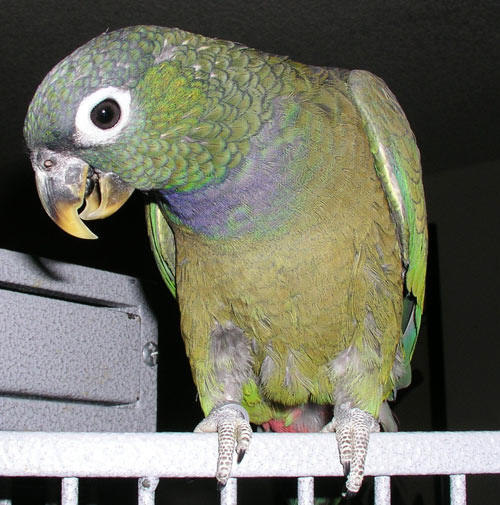 Description: green; forehead and lores blackish; feathers on crown and
back of head broadly edged with dark grey; cheeks green with narrow bluish-grey
tips; violet-blue band across throat and upper breast; breast and abdomen pale
green; under tail-coverts red; back and upper wing-coverts dull olive-brown;
middle tail feathers green, outer blue with red base; bill horn-colored with
black base; skin to periophthalmic ring grey; iris dark brown; feet grey. Description: green; forehead and lores blackish; feathers on crown and
back of head broadly edged with dark grey; cheeks green with narrow bluish-grey
tips; violet-blue band across throat and upper breast; breast and abdomen pale
green; under tail-coverts red; back and upper wing-coverts dull olive-brown;
middle tail feathers green, outer blue with red base; bill horn-colored with
black base; skin to periophthalmic ring grey; iris dark brown; feet grey.
Off Springs: mostly
with reddish frontal band; head pale green with narrow edging; poorly developed
violet-blue band to throat and upper breast.
Weight & Length: 235-260 grams. 29 cm (11.5 ins)
Distribution:
northeast
Brazil from
Espírito Santo north to Piauí and Ceará.
Habits: pairs, small groups or flocks of up to 50
birds outside breeding season; occasionally flocks of several hundred birds when
sufficient food available; mostly seen flying as difficult to detect in trees;
plumage provides excellent camouflage; very noisy when flying to and from
roosting trees; audible for considerable distance; quiet when feeding; shy and
unapproachable; call high-pitched and disyllabic; alarm call rapidly repeated
cries.
Natural
diet:
fruits (wild figs), nuts, berries and seeds, foraged in
trees and bushes.
Breeding
behavior: breeding season from October to February;
nests in tree hollows or hollow branches of dead trees; mostly at height of at
least 10 m (35 ft); egg measures 32.2 x 24.4 mm (1.27 x 0.96 ins).
Aviculture:
very quiet parrot, which seldom screeches; newly imported
birds not so anxious as other Pionus species; not hard chewer; hardy once
acclimatized; can be housed in communal aviary with other Pionus species.
Accommodation: aviary of 2.5 x 1 x 2 m (8.5 x 3 x 6 ft); minimum
temperature 5°C (41°F); not less than 20°C (68°F) during acclimatization.
Diet: various fruit and vegetables; variety of seed mixes; sprouted food
in spring/summer; fresh branches with flowers and buds; regular mineral
supplements; rearing food or dog chow, soft or cottage cheese before and during
breeding; occasionally conservative in feeding habits and difficult to accustom
to new food.
Breeding in
aviculture: seldom achieved as not often kept; breeding
does not seem to be difficult; clutch 3 to 4 eggs; brooded from laying of first
egg; incubation 26 days; fledging period 60 days; young independent after 80
days; nest box 25 x 25 x 60 cm (10 x 10 x 24 ins); provide plenty of greenery
for breeding.
|
|
White-Capped / White Crowned
(Pionus senilis)
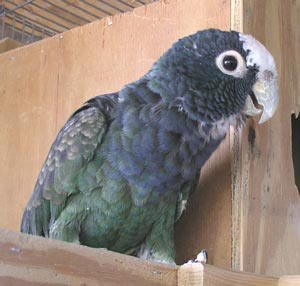 Description: generally green; lores, forehead,
fore crown and patch on chin white; remaining head feathers green edged with
blue; ear-coverts dark blue; breast olive-brown, feathers edged with lilac-blue,
becoming green on abdomen; under tail-coverts red with green edging; lesser and
median wing-coverts gold-brown with green base; primary-coverts and primaries
violet-blue; under wing-coverts greenish-blue; tail green with blue tips, outer
feathers blue with red base; bill horn-colored: skin to periophthalmic ring
whitish-pink; iris brown; feet grey flesh-colored. Description: generally green; lores, forehead,
fore crown and patch on chin white; remaining head feathers green edged with
blue; ear-coverts dark blue; breast olive-brown, feathers edged with lilac-blue,
becoming green on abdomen; under tail-coverts red with green edging; lesser and
median wing-coverts gold-brown with green base; primary-coverts and primaries
violet-blue; under wing-coverts greenish-blue; tail green with blue tips, outer
feathers blue with red base; bill horn-colored: skin to periophthalmic ring
whitish-pink; iris brown; feet grey flesh-colored.
Off Springs: with
green head; forehead white; chin, breast and abdomen green; under tail-coverts
lighter; iris dark.
Weight & Length: 185-220 grams. 24 cm (9.5 ins)
Distribution: from west
Panama north to
south-east Mexico in San Luis Potosi and southern Tamaulipas, mainly along
Pacific slopes.
Habitat: forests and coastal areas with woodland in tropical and
sub-tropical zone up to 2,500 m (7,500 ft); occurs occasionally in cultivated
areas.
Status: fairly common; numerous in localities.
Habits: from small groups to flocks of several hundred birds outside
breeding season; seasonal migrations to and from higher altitudes; quiet during
feeding; then difficult to detect in foliage; cautious and shy; does not come
down to ground; if alarmed flies away screeching loudly; flight swift and noisy;
flock flies and also changes direction suddenly in unison; call often incessant
shrill screeching.
Natural
diet: fruits, seeds, nuts, berries and flowers; maize and grain
in cultivated areas.
Breeding
behavior:
breeding season February to May; nests in holes
in trees at 5 m (15 ft) to 8 m (24 ft); after breeding adults and off springs form
larger flocks; egg measures 34,9 x 25,4 mm (1.37 x 1.0 ins).
Aviculture: medium-noisy, lively parrot; initially shy, later more
confiding; often incompatible with other birds; only minor chewing requirement.
Accommodation:
aviary of 3 x 1 x 2 m (9 x 3 x 6 ft); during
acclimatization minimum temperature 20°C 68°F); in winter not less than 10°C
(50°F); double wiring, as species can be aggressive towards neighboring birds.
Diet:
various fruit and vegetables; good, varying seed mix; sprouted seed
in spring and early summer; fresh branches with buds; regular mineral
supplements; rearing food or dog chow, quark (cottage or soft cheese) before and
during breeding.
Breeding in
aviculture: seldom achieved; breeding begins in April; 4
to 5 eggs; incubation 26 days; fledging 60 days; adults occasionally sensitive
to nest inspection; nest box 24 x 24 x 50 cm (9.5 x 9.5 x 20 ins).
|
|
Dusky
(Pionus Fuscus)
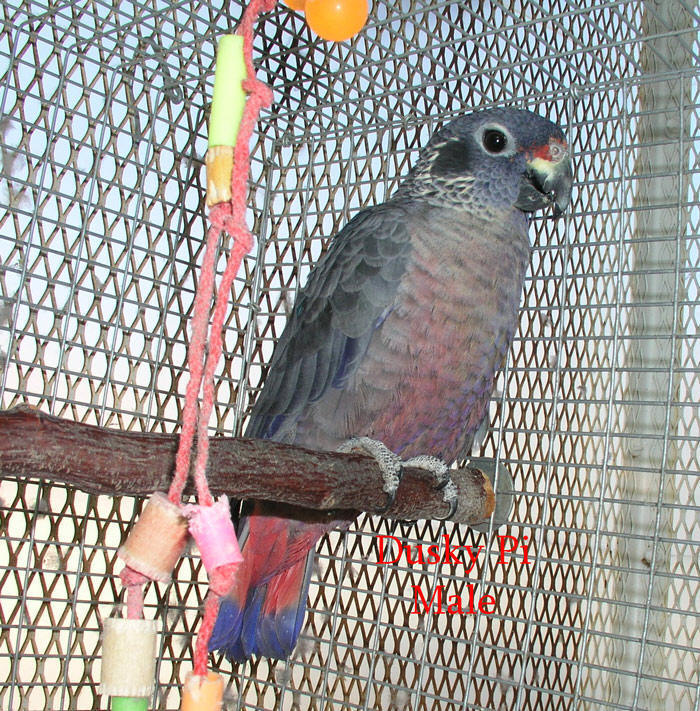
Adults:
head dull slate-blue; red spot
on either side of forehead; ear-coverts black; feathers of throat
and sides of neck tipped with dusky white thus producing an
indistinct collar; feathers of chin edged with dull pink; upper
parts dark brown and paler edges to feathers; underparts brown,
feathers variably edged with purple-red or reddish-blue; under
tail-coverts dull red; primary-coverts and flight feathers
purple-blue; under wing-coverts and undersides of flight feathers
deep violet-blue; tail dark blue with red at bases of lateral tail-
feathers; bill dark gray with yellow towards base of upper mandible;
iris brown; legs gray.
Immatures:
like adults, but some upper wing-coverts edged with green;
greenish tinge on secondaries.
Weight & Length:
Weight 180-222 gram Length 24 cm. (9.8 in.)
Although the Dusky now bred by a few
breeders in the U.S., is still not quite as common as the Maximilian, Blue Head,
Bronze Wing or White Cap.
|
|
Coral-Billed /
Red-Billed
(Pionus sordidus)
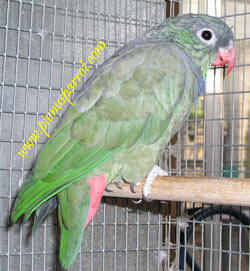 Adults:
head olive-green, feathers of
crown Adults:
head olive-green, feathers of
crown
and occiput broadly edged with dark blue; cheeks olive, feathers tipped
with blue; chin and band across throat blue; breast buff-olive, each
feather sub-terminally tinged with dull mauve-pink; abdomen buff-olive
slightly with dull pink; under tail-coverts red; upperparts dull olive
green, each feather margined with paler olive-brown; primary-coverts and
flight feathers green, outermost primary edged with blue on outer web;
under wing-coverts and undersides of flight feathers green; central
tail-feathers green, lateral feathers blue basally barred with red;
exposed skin of the periophthalmic is grey; iris dark brown; feet and legs dark gray.
Immature: head, throat and breast
pale green; feathers of crown narrowly edged with blue; under tail-coverts
yellowish-green variably marked with red.
Weight & Length:
Weight 240-260 grams.
28 cm. (12 in.)
There are 6 subspecies of the Red Billed.
The one most found in aviculture is described here.
|
| Plum-Crowned
(Pionus tumultuosus)
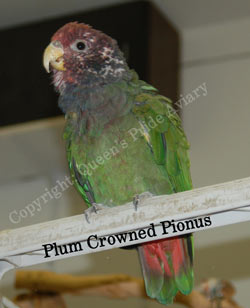
Adults:
general plumage green, paler on
underparts; feathers of sides of head with white bases showing through,
particularly on lores and below eyes, and tipped with purple; crown and
nape dark red; hindneck, sides of neck and breast reddish-purple, becoming
less reddish on breast; under tail-coverts red tinged with purple and
edged with yellowish-green; under wing-coverts and undersides of flight
feathers dull green; central tail-feathers green, lateral feathers green
tipped with violet-blue and basally barred with red; bill olive-yellow;
iris brown; legs greenish gray.
Immatures: nape and hind crown
dark green like back; throat rose-red as in adult, but cheeks and breast
green; under tail-coverts yellowish-green basally marked with pink.
The Plum Crowned is rarely bred in
captivity. There has been no subspecies described or known.
Copyright courtesy photo image was submitted by:
Queen's Pride Aviary
|
|
Whited-Headed
(Pionus
seniloides)
No Photo Yet!
Adults: general plumage green, slightly
paler on the lower under parts; feathers of forehead and crown white
becoming grayish towards orange-red tips; feathers of occiput, nape
and sides of neck white at base, then grayish-blue and margined with
violet-black; ear coverts dark gray with pink centres; feathers of
hindneck pinkish-white; feathers of lores and cheeks white edged with
grey, edgings becoming darker and more pronounced towards posterior of
cheeks; feathers of anterior of cheeks sometimes edged with orange-red;
pink band on throat merging into reddish-mauve on breast, which in turn
blends into brown of abdomen; under tail-coverts red; under wing-coverts
and undersides of flight feathers dull green; central tail-feathers green,
lateral feathers green tipped with dull purple and basally marked with
red; bill pale olive-yellow; iris brown; legs greenish gray.
Immatures: feathers of head green
with white bases, those of crown also narrowly edged with dull red;
feathers of side head white margined with green; throat and breast green,
feathers with dull reddish - mauve centres.
Extremely rare in captivity or bred.
There has been no subspecies described or known, although some authorities
consider the White Headed parrot to be a sub-specie of the Plum
Crowned parrot.
|
Top of
Page Pionus Online Home Page
About Pionus Online
|
Questions and
Answers |
Frequently Asked
Questions | Technical Descriptions
|
Photo Details
Pionus Facts
|
Pionus Diet
|
Health Care
|
Purchasing a Pionus
|
Caging and
Toys |
Contact Us |
Pionus Links
This is a sister site to:
www.pionusparrot.com
www.pionusonline.com
©2002-2021
Pionus Parrot - All Rights Reserved
June 2, 2021
|


 Description:
Description: Description:
Description: Description:
Description: Description:
Description:
 Adults:
head olive-green, feathers of
crown
Adults:
head olive-green, feathers of
crown